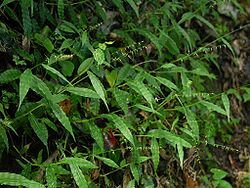| Wavyleaf basketgrass | |
|---|---|
 | |
| Scientific classification | |
| Kingdom: | Plantae |
| Clade: | Tracheophytes |
| Clade: | Angiosperms |
| Clade: | Monocots |
| Clade: | Commelinids |
| Order: | Poales |
| Family: | Poaceae |
| Subfamily: | Panicoideae |
| Genus: | Oplismenus |
| Species: | O. undulatifolius |
| Binomial name | |
| Oplismenus undulatifolius | |
| Synonyms [2] | |
| |
Oplismenus undulatifolius, commonly known as wavyleaf basketgrass, is a species of perennial grass from the family Poaceae that is native to Eurasia, specifically Southern Europe through Southern Asia. [3] [4] Due to its invasive nature, it can be found in countries such as Pakistan (Punjab & Kashmir), [2] China, Japan, [5] Korea, India, Australia, [6] South Africa, [2] and has since been introduced to the Mid-Atlantic United States. There are no recognized subspecies in Catalogue of Life. [7]





